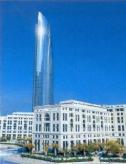
source: MEP Middle East magazine
Consisting of three components, the Studor System has gained increased acceptance for use in multi-story buildings. The components are the Maxi-Vent, Mini-Vent and P.A.P.A. The Mini-Vent protects fixtures on the branch of the system. When used together, the P.A.P.A. (positive air pressure attenuator) and Maxi-Vent protect the stack against positiveandnegative pressures.
This combination provides a perfect balance in returning the drainage system back to atmospheric pressure without the siphonage of any traps. The P.A.P.A. is a revolutionary product developed to protect buildings of 10+ stories against the unwanted positive pressures (transients, back-pressure) generated in the system.
Other advantages of the Studor system include:
*It replaces excessive piping, saving costs in materials and installation;
*Provides greater freedom of design for engineers, architects and design professionals;
*Eliminates the risk of water leakages through roof penetrations because no roof penetrations are required-regardless of how tall the building;
*Reduces the need for fire stopping devices, preventing the chimney effect in the pipe and reducing the risk of fire spreading upwards between floors;
*Requires no specialist installation or maintenance;
*Can be retrofitted into an existing drainage system; and
*Prevents transmission of odorous sewer gas.
This system is being installed in the D1 tower (shown), an 80-story luxury residential living development, and Palazzo Versace hotel, which are situated side-by-side on the Dubai Creek (Arab Emirates). “The benefits of having a simple, dedicated high-rise drainage system apparently made its use a clear decision for specification in these cases,” notesMEP Middle East magazine about the project.
“Of particular importance for the design was eliminating roof penetrations, reducing installation space and saving costs (both in materials and labor), as well as producing a high performance and reliable single-stack drainage system.”
